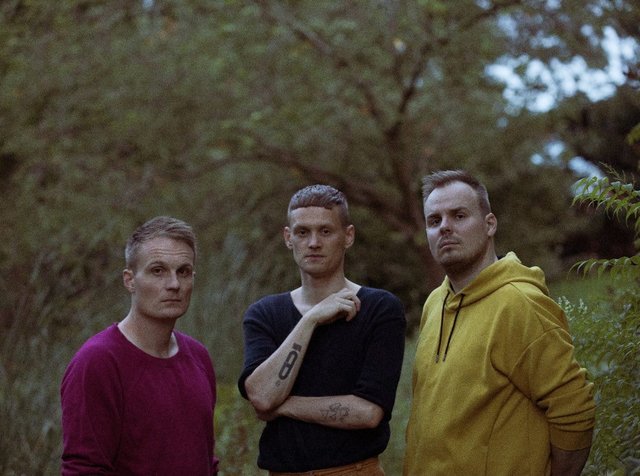HIRAKI Writhe In Your Subconscious - Interview

The thriving scene of noise influenced punk bands is connected by unsightliness. Each act instills dread, like the industrial pulses of Street Sects or the unhinged trembling of Daughters. HIRAKI vocalist/synth player Jon Gotlev and guitarist Tue Schmidt Rasmussen admit it’s humbling to be compared to these groups.
More than their contemporaries, more than fellow Dane Lars von Trier’s series The Kingdom, even more than Swedish eurodance group Team Rockit - whom Gotlev particularly admires - HIRAKI is the product of intergroup chemistry. “HIRAKI is a state of mind. When we are together as HIRAKI it’s constantly ongoing because everything is evolving,” says Rasmussen.
The Danish synthpunks released their second album Stumbling Through the Walls last month via Nefarious Industries. It is a surgeon’s knife to the throat. It inspects the overlap between internal demons and external ramifications. HIRAKI are aware, proud even, of how fucked up it sounds. Rasmussen says, “We knew someone would listen to it and we wondered how the fuck they were going to react.” Specific influences poke out on Stumbling Through the Walls. Rasmussen and Gotlev cite The Body and Full of Hell’s Ascending a Mountain of Heaven Light as revelatory. Rasmussen champions “the sound and vibe of it, how the master is distorted, everything is punchier than punchy.”
Gotlev and Rasmussen have played together for over a decade. They met as members of the progressive rock group Lis Er Stille (Liserstille), establishing a collaborative partnership they furthered with longtime friend Tim Frederiksen upon forming HIRAKI . The cooperative writing process is their most cherished aspect of the band. “There’s freedom to bring in whatever you wanna do. For example our bass player started playing bass. He eventually played everything but the bass,” Rasumussen says. The group’s democracy expands into every aspect of the album. Each member had a hand in everything on Stumbling Through The Walls. After recording they handled production, press work, and the artwork themselves. The album’s cover was of vested interest to Gotlev - who moonlights as an art designer under the name NO HEROES - and Frederiksen, who has a history with graphic design.
The record’s intensity proliferated in a claustrophobic and extended recording process. HIRAKI put four years of work into Stumbling Through the Walls after releasing their debut LP in 2017. They acquired their own space to record and rehearse, suitably named the Cube of Eternal Doom Studio. Lapses in writing and recording were common due to COVID-19. This gifted HIRAKI more time to dissect their own underlying sentiments amidst the shakiness of the pandemic. “Given that we paused between recordings the whole process was coloured by the state of the world and where we were because things were constantly changing. Being outside of the recording studio and returning we would take stuff in without knowing it. That’s maybe why the album is so fucked up. It’s a massive clusterfuck of feelings and world states,” says Gotlev.
The Cube of Eternal Doom Studio's splatter movie-like aura fostered the trio's creativity. “The recording space is an old freezer. No windows. It’s like a casino where you go in and you have no idea what time it is. You go in there and time is just gone,“ Gotlev says. Rasumussen asserts the studio nourished their visceral performance. “When we compose it’s very physical because we rehearse in a small room. The sound is dense. We feed a lot from the density of the sound.”
The true horror of Stumbling Through the Walls is its interrogative tone. Gotlev describes the album’s thesis as “how we create and destroy the world as individuals. It’s both an album pointing fingers at people while pointing them back at ourselves. Looking outward and seeing all the stuff we’re angry about while looking inward to see what we’re doing to make a change.” Like any quality horror piece Stumbling Through the Walls houses as many moments of noose-tight tension as it does splatters of blood. Gotlev plays horror films ad nauseam as he works. Akira and The Shining were his background muses when designing the album cover. The minimalist cover distills HIRAKI’s venom to a single question. “The artwork has the concept of being an individual that could be everybody. The person trying to hide what they can't, or wanting to look even though they shouldn’t,” Gotlev says. HIRAKI asks how we reconcile with our participation in horror.
In contrast to the suffocating grip of their music HIRAKI are light, airy, and rooted in companionship. There’s no judgment between members. They welcome the tumultuous interplay of individuals and their influence on each other. “We have been composing together for a long time but teaming up with longtime friend Tim shook everything up. He’s a different musician from Jon and I,” Rasmussen says. Their freedom with each other, along with their bloody shack of a recording studio, fed into one of the most punishing albums of the year. Which is how they wanted it to be. “We composed the record exactly how we wanted to make it sound. That’s what I’m the most proud of - we did it the way the three of us wanted it to sound. We made it for us,” Gotlev proclaims.
Connect with HIRAKI via
Posted from my blog with Exxp : https://fortheloveofbands.com/2021/05/03/hiraki-writhe-in-your-subconscious-interview/